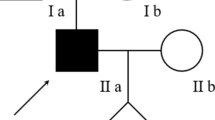Abstract
Purpose
To present the first case proposing the use of preimplantation genetic testing for monogeneic disorders for Kallmann syndrome, providing comprehensive care in the genomic era of precision medicine.
Methods
Gonadotropin therapy was used for spermatogenesis, followed by in vitro fertilization by intracytoplasmic sperm injection and embryo transfer. Cross-generational targeted next-generation sequencing was then done for genes known to cause Kallmann syndrome.
Results
A heterozygous mutation at codon 102 of the FGFR1 gene was found in the patient, but the father was found to have the same mutation yet is unaffected by Kallmann syndrome. Since no causative mutation was found, a de novo or sporadic mutation was suspected as the cause of Kallmann syndrome in this case.
Conclusions
Comprehensive care must be available for male Kallmann syndrome patients, as treatment should not stop at spermatogenesis, but continue with genetic counseling due to possible inheritance.

Similar content being viewed by others
References
Young J. Approach to the male patient with congenital hypogonadotropic hypogonadism. J Clin Endocrinol Metab. 2012;97(3):707–18.
Young J, Xu C, Papadakis GE, Acierno JS, Maione L, Hietamäki J, et al. Clinical management of congenital hypogonadotropic hypogonadism. Endocr Rev. 2019;40(2):669–710.
Costa-Barbosa FA, Balasubramanian R, Keefe KW, Shaw ND, al-Tassan N, Plummer L, et al. Prioritizing genetic testing in patients with Kallmann syndrome using clinical phenotypes. J Clin Endocrinol Metab. 2013;98(5):E943–53.
Maione L, Dwyer AA, Francou B, Guiochon-Mantel A, Binart N, Bouligand J, et al. Genetics in endocrinology: genetic counseling for congenital hypogonadotropic hypogonadism and Kallmann syndrome: new challenges in the era of oligogenism and next-generation sequencing. Eur J Endocrinol. 2018;178(3):R55–r80.
Topaloglu AK. Update on the genetics of idiopathic hypogonadotropic hypogonadism. J Clin Res Pediatr Endocrinol. 2017;9(Suppl 2):113–22.
Gao Y, Yu B, Mao J, Wang X, Nie M, Wu X. Assisted reproductive techniques with congenital hypogonadotropic hypogonadism patients: a systematic review and meta-analysis. BMC Endocr Disord. 2018;18(1):85.
Gardner DK, S.W.I.v.c.o.h.b.I.J.R., Mortimer D, editors. Toward reproductive certainty: fertility and genetics beyond 1999. UK: Parthenon Publishing London; 1999. p. 378-388.
The Istanbul consensus workshop on embryo assessment: proceedings of an expert meeting. Hum Reprod, 2011. 26(6): p. 1270-83.
Stenson PD, Ball EV, Mort M, Phillips AD, Shiel JA, Thomas NS, et al. Human Gene Mutation Database (HGMD): 2003 update. Hum Mutat. 2003;21(6):577–81.
Kim SH. Congenital hypogonadotropic hypogonadism and Kallmann syndrome: past, present, and future. Endocrinol Metab (Seoul). 2015;30(4):456–66.
Quaynor SD, Bosley ME, Duckworth CG, Porter KR, Kim SH, Kim HG, et al. Targeted next generation sequencing approach identifies eighteen new candidate genes in normosmic hypogonadotropic hypogonadism and Kallmann syndrome. Mol Cell Endocrinol. 2016;437:86–96.
Boehm U, Bouloux PM, Dattani MT, de Roux N, Dodé C, Dunkel L, et al. Expert consensus document: European Consensus Statement on congenital hypogonadotropic hypogonadism--pathogenesis, diagnosis and treatment. Nat Rev Endocrinol. 2015;11(9):547–64.
Author information
Authors and Affiliations
Corresponding author
Ethics declarations
Conflict of interest
The authors declare that they have no conflict of interest.
Additional information
Publisher’s note
Springer Nature remains neutral with regard to jurisdictional claims in published maps and institutional affiliations.
Rights and permissions
About this article
Cite this article
Chan, C., Wang, CW., Chen, CH. et al. Live birth in male de novo Kallmann syndrome after cross-generational genetic sequencing . J Assist Reprod Genet 36, 2481–2484 (2019). https://doi.org/10.1007/s10815-019-01604-9
Received:
Accepted:
Published:
Issue Date:
DOI: https://doi.org/10.1007/s10815-019-01604-9




